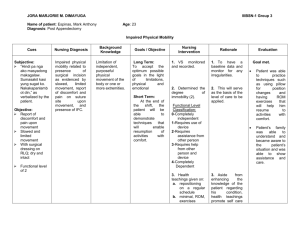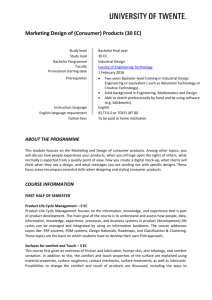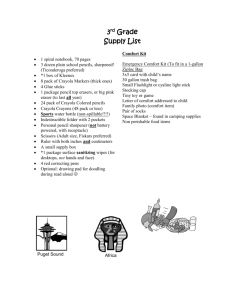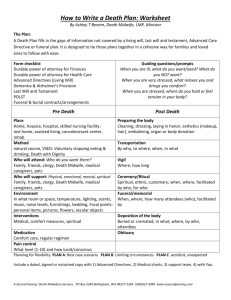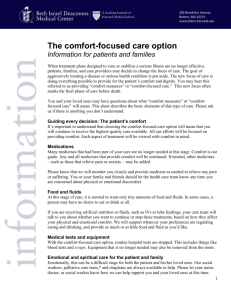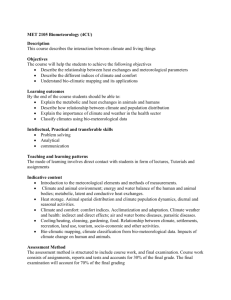Comfort: A Concept Analysis
advertisement
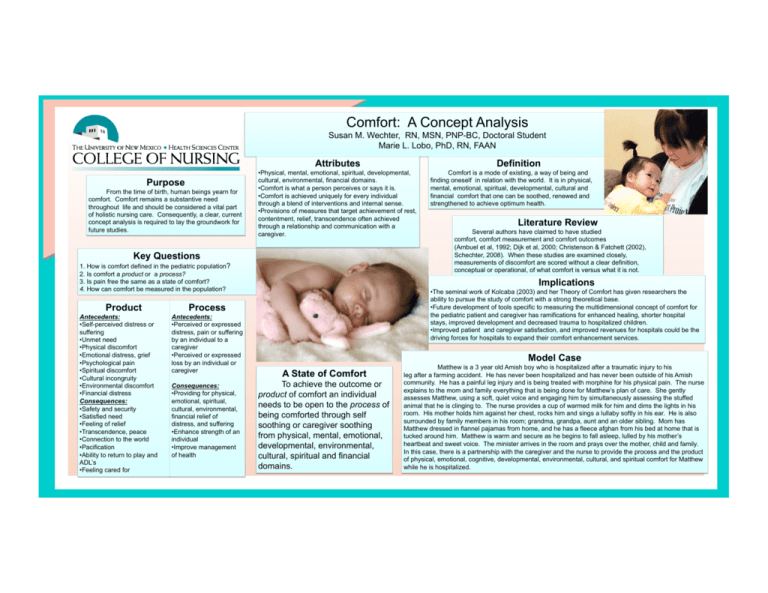
Comfort: A Concept Analysis Susan M. Wechter, RN, MSN, PNP-BC, Doctoral Student Marie L. Lobo, PhD, RN, FAAN Attributes Purpose From the time of birth, human beings yearn for comfort. Comfort remains a substantive need throughout life and should be considered a vital part of holistic nursing care. Consequently, a clear, current concept analysis is required to lay the groundwork for future studies. Key Questions 1. How is comfort defined in the pediatric population? 2. Is comfort a product or a process? 3. Is pain free the same as a state of comfort? 4. How can comfort be measured in the population? Product Antecedents: • Self-perceived distress or suffering • Unmet need • Physical discomfort • Emotional distress, grief • Psychological pain • Spiritual discomfort • Cultural incongruity • Environmental discomfort • Financial distress Consequences: • Safety and security • Satisfied need • Feeling of relief • Transcendence, peace • Connection to the world • Pacification • Ability to return to play and ADL’s • Feeling cared for Consequences: • Providing for physical, emotional, spiritual, cultural, environmental, financial relief of distress, and suffering • Enhance strength of an individual • Improve management of health Comfort is a mode of existing, a way of being and finding oneself in relation with the world. It is in physical, mental, emotional, spiritual, developmental, cultural and financial comfort that one can be soothed, renewed and strengthened to achieve optimum health. Literature Review Several authors have claimed to have studied comfort, comfort measurement and comfort outcomes (Ambuel et al, 1992; Dijk et al, 2000; Christenson & Fatchett (2002), Schechter, 2008). When these studies are examined closely, measurements of discomfort are scored without a clear definition, conceptual or operational, of what comfort is versus what it is not. Implications • The seminal work of Kolcaba (2003) and her Theory of Comfort has given researchers the ability to pursue the study of comfort with a strong theoretical base. • Future development of tools specific to measuring the multidimensional concept of comfort for the pediatric patient and caregiver has ramifications for enhanced healing, shorter hospital stays, improved development and decreased trauma to hospitalized children. • Improved patient and caregiver satisfaction, and improved revenues for hospitals could be the driving forces for hospitals to expand their comfort enhancement services. Process Antecedents: • Perceived or expressed distress, pain or suffering by an individual to a caregiver • Perceived or expressed loss by an individual or caregiver Definition • Physical, mental, emotional, spiritual, developmental, cultural, environmental, financial domains. • Comfort is what a person perceives or says it is. • Comfort is achieved uniquely for every individual through a blend of interventions and internal sense. • Provisions of measures that target achievement of rest, contentment, relief, transcendence often achieved through a relationship and communication with a caregiver. Model Case A State of Comfort To achieve the outcome or product of comfort an individual needs to be open to the process of being comforted through self soothing or caregiver soothing from physical, mental, emotional, developmental, environmental, cultural, spiritual and financial domains. Matthew is a 3 year old Amish boy who is hospitalized after a traumatic injury to his leg after a farming accident. He has never been hospitalized and has never been outside of his Amish community. He has a painful leg injury and is being treated with morphine for his physical pain. The nurse explains to the mom and family everything that is being done for Matthew’s plan of care. She gently assesses Matthew, using a soft, quiet voice and engaging him by simultaneously assessing the stuffed animal that he is clinging to. The nurse provides a cup of warmed milk for him and dims the lights in his room. His mother holds him against her chest, rocks him and sings a lullaby softly in his ear. He is also surrounded by family members in his room; grandma, grandpa, aunt and an older sibling. Mom has Matthew dressed in flannel pajamas from home, and he has a fleece afghan from his bed at home that is tucked around him. Matthew is warm and secure as he begins to fall asleep, lulled by his mother’s heartbeat and sweet voice. The minister arrives in the room and prays over the mother, child and family. In this case, there is a partnership with the caregiver and the nurse to provide the process and the product of physical, emotional, cognitive, developmental, environmental, cultural, and spiritual comfort for Matthew while he is hospitalized.
